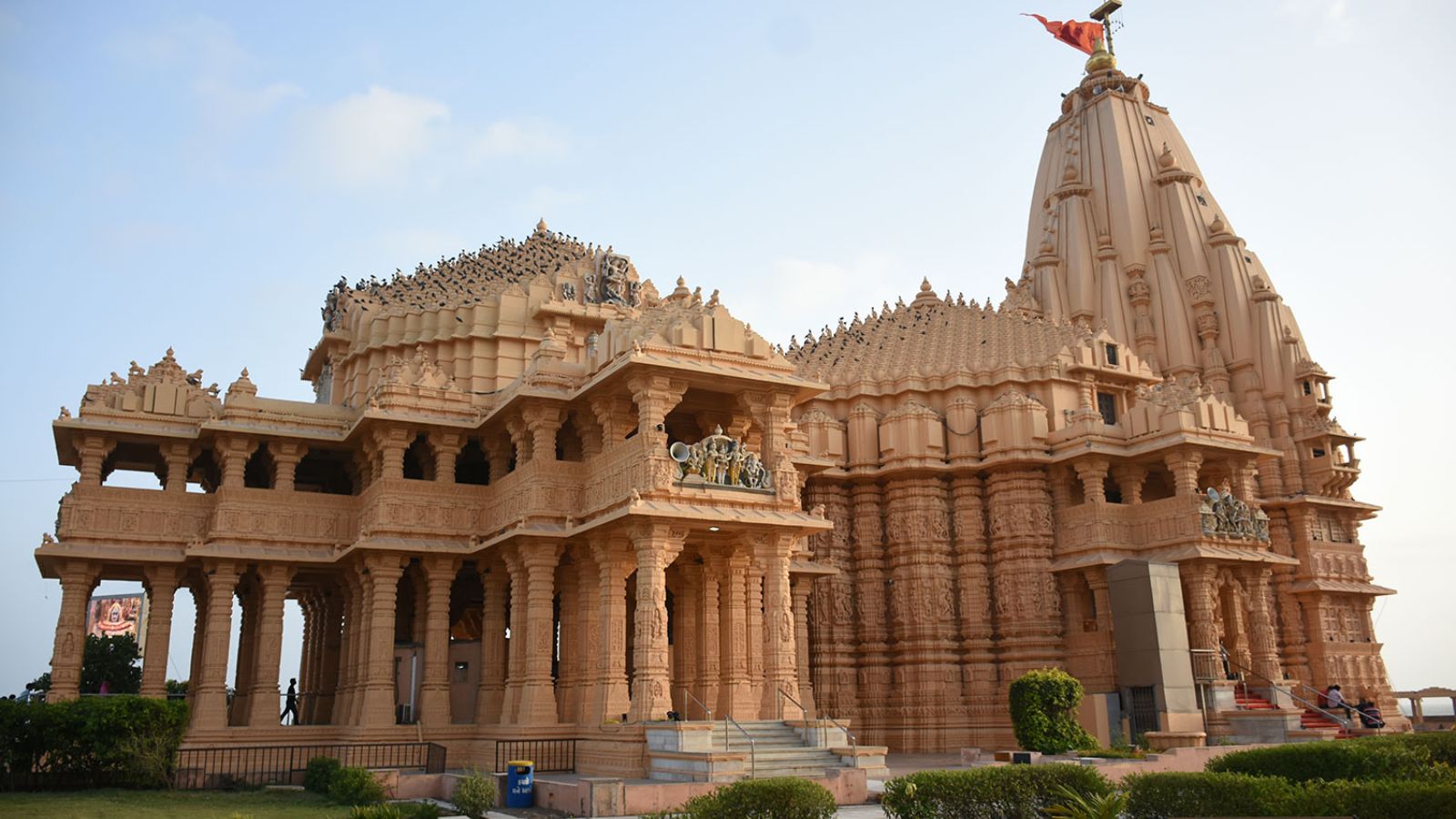The Magnificent Somnath Temple: A Journey through Time and Spirituality

Strong 8k brings an ultra-HD IPTV experience to your living room and your pocket.
The Somnath Temple, located on the western coast of Gujarat, India, is one of the most revered and ancient Hindu temples dedicated to Lord Shiva. Somnath, which translates to "The Protector of the Moon God," is not just an architectural marvel but also a symbol of resilience and devotion. The temple is considered the first of the twelve Jyotirlingas, which are sacred shrines representing Lord Shiva. Let’s dive into the rich history, spiritual significance, and unmatched beauty of this magnificent structure.
The Spiritual Significance of Somnath Mandir
Somnath Mandir holds an esteemed position in Hinduism. It is believed that Lord Shiva appeared in his Jyotirlinga form here to bless devotees and relieve them of their suffering. The temple is more than just a place of worship; it’s a spiritual destination where the divine and earthly realms meet. Every year, millions of pilgrims come to Somnath to seek Lord Shiva’s blessings and find inner peace.
Historical Background of Somnath Temple
The First Temple and Its Origins
The history of Somnath Temple dates back thousands of years. According to ancient Hindu scriptures, the original temple was built by the Moon God, Soma, in gold. It was later rebuilt by Ravana in silver, Krishna in wood, and finally by King Bhimdev in stone. This historical continuity makes Somnath a unique blend of mythology and reality.
Destruction and Rebuilding of Somnath
Somnath has faced several invasions and destruction throughout its history. It was first destroyed by Mahmud of Ghazni in 1026 AD. However, its significance was so immense that it was rebuilt several times over the centuries, with the latest reconstruction occurring in 1951 under the guidance of Sardar Vallabhbhai Patel. Each time it was rebuilt, the temple stood as a testament to the unshakable faith of Hindus.
Architectural Marvels of Somnath Temple
Design and Layout
The Somnath Temple is an example of Chalukyan-style architecture, which is renowned for its intricate carvings, towering spires, and grand gateways. The temple is positioned strategically on the shore, facing the Arabian Sea, and offers a breathtaking view of the ocean from its premises.
Key Features of Somnath Temple’s Structure
The temple's main shrine houses the Jyotirlinga, which is worshipped daily. The massive shikhara (spire) of the temple rises 150 feet high, and the temple complex is adorned with sculptures that depict scenes from Hindu mythology. The temple also features a grand Sabha Mandap (assembly hall) and a beautiful Nandi (bull) statue at the entrance.
Location of Somnath Temple
Geography of Somnath, Gujarat
Somnath is located in the Prabhas Patan district of Gujarat, on the western coast of India. The temple sits near the confluence of three rivers—Kapila, Hiran, and Saraswati—which adds to its spiritual importance.
Connectivity to the Temple
The temple is well-connected by road, rail, and air. The nearest airport is in Diu, about 85 kilometers away, and there are regular trains and buses connecting Somnath to major cities like Ahmedabad and Rajkot.
Importance in Hinduism
Association with Lord Shiva
Somnath is one of the twelve Jyotirlingas, which are considered the most sacred abodes of Lord Shiva. According to Hindu belief, visiting these Jyotirlingas can cleanse one’s sins and bring spiritual enlightenment.
Legends and Stories Surrounding Somnath Temple
One of the most famous legends is about the Moon God, Soma, who was cursed by his father-in-law, Daksha, to lose his luster. Soma prayed to Lord Shiva, who freed him from the curse, and in gratitude, Soma built the first Somnath Temple.
Pilgrimage and Religious Festivals
Shivaratri Celebrations
One of the most significant events at Somnath is Maha Shivaratri, a festival dedicated to Lord Shiva. Devotees from all over the country gather at the temple to participate in night-long prayers and rituals.
Other Festivals and Rituals
Apart from Shivaratri, various Hindu festivals such as Kartik Purnima and Diwali are celebrated with great fervor at Somnath Temple, drawing huge crowds of devotees and tourists.
Somnath Mandir Today
Modern Facilities and Amenities
Somnath Mandir today is equipped with modern amenities for pilgrims and tourists. From well-maintained guesthouses to guided tours and information centers, the temple ensures a comfortable experience for its visitors.
Attractions Around Somnath Temple
The Somnath temple complex is surrounded by various other religious and cultural attractions, including the Prabhas Patan Museum, which houses ancient relics, and the Triveni Sangam, where the rivers meet the sea.
The Role of the Somnath Trust
Maintenance and Preservation
The Somnath Trust is responsible for the upkeep and management of the temple. It ensures that the ancient traditions are preserved while modernizing the temple’s infrastructure.
Contributions to Religious and Cultural Activities
The trust also organizes religious and cultural events throughout the year, promoting spiritual learning and preserving the rich heritage of Somnath.
Famous Visitors and Historical Figures
Over the centuries, Somnath has attracted many notable figures, including kings, poets, and modern leaders like Mahatma Gandhi and Sardar Patel. Their visits have added to the temple’s historical importance.
How to Plan Your Visit to Somnath Mandir
Best Time to Visit
The best time to visit Somnath is between October and March, when the weather is pleasant. Avoid visiting during the summer months as the temperatures can soar.
Travel Tips and Guidelines
Make sure to dress conservatively while visiting the temple. Cameras and mobile phones are not allowed inside the temple, so plan accordingly.
Nearby Attractions in Gujarat
Gir National Park
Located about 70 kilometers from Somnath, Gir National Park is home to the majestic Asiatic lions and offers a thrilling wildlife experience.
Dwarka and Other Temples
Dwarka, another important pilgrimage site, is located a few hours away from Somnath. Visiting both temples offers a rich spiritual journey across Gujarat.
Somnath Temple in Indian Culture
Somnath has been a significant part of Indian culture and history for millennia. It has inspired countless works of art, literature, and devotion, and continues to be a source of pride for Hindus worldwide.
Conclusion: Why Somnath is More than Just a Temple
Somnath Temple is not just a place of worship; it’s a symbol of the eternal strength and devotion of the Hindu faith. Its rich history, spiritual significance, and architectural beauty make it a must-visit destination for anyone interested in Indian culture, history, or spirituality.
Note: IndiBlogHub features both user-submitted and editorial content. We do not verify third-party contributions. Read our Disclaimer and Privacy Policyfor details.







